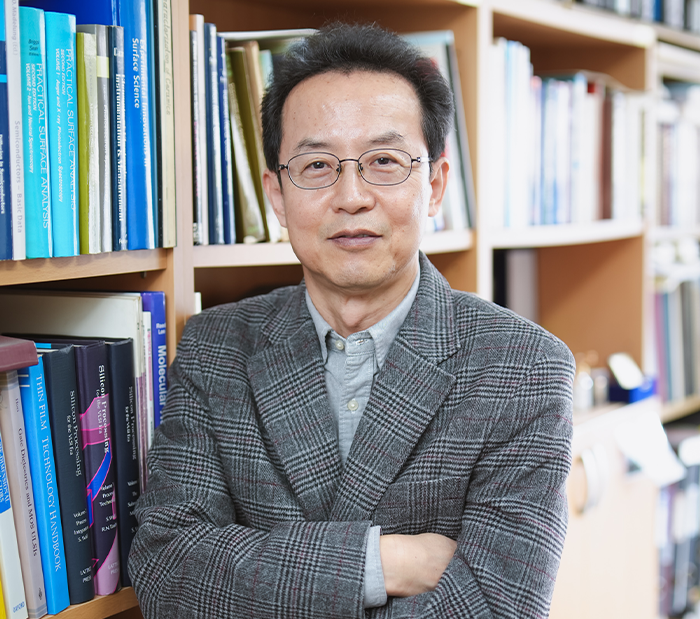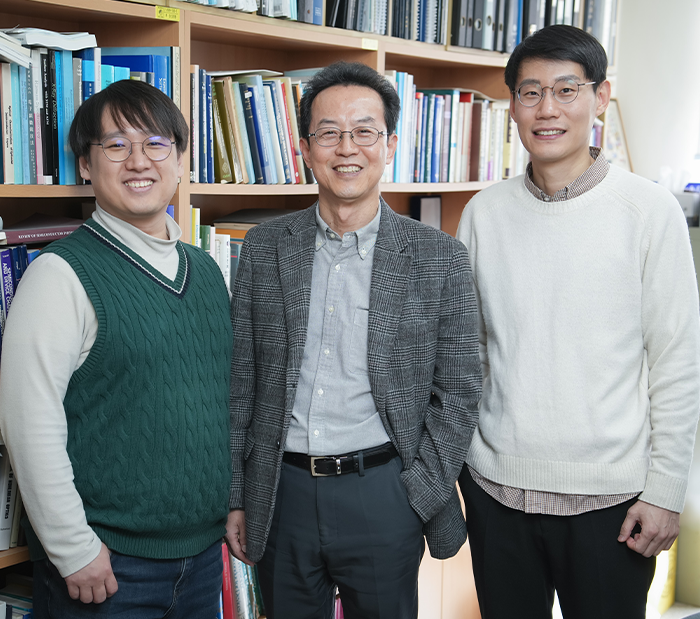Predicting and demonstrating of hidden metastable phase in transition metal oxide
Advanced Materials Science and Engineering LEE, JAICHAN Prof. · Bongwook Chung
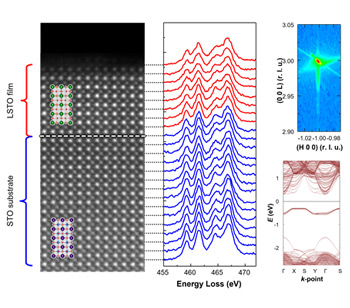
-
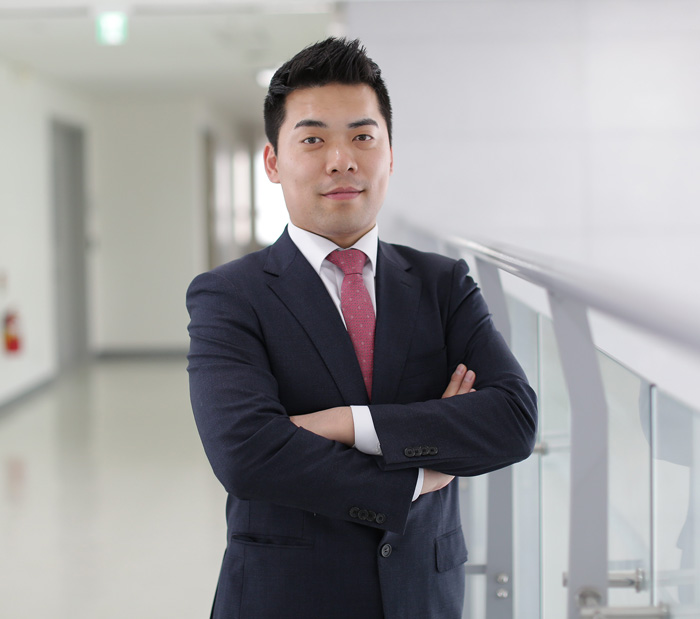
Biomedical Engineering PARK, CHUN GWON Prof.
Prof. Won Sub YOON develops high-performance battery that can travel up to 400km with one charge
A research team led by Prof. Won-Sub YOON, Department of Energy Science (DOES) at Sungkyunkwan University, has lifted the fundamental restriction on the breaking point of the lattice and unraveled the enigma of nickel effect on layered cathode materials that has existed for decades in the battery field. Consequently, they discovered the possibility of developing a high-performance battery which can travel up to 400km by one charge. While the technology of lithium ion batteries has been greatly successful since its advent in powering portable electronic devices, further advancements are insatiably demanding for wider applications such as in electric vehicles and grid-power storages. One of the key areas in these efforts is development of new positive electrode ‘cathode’ materials with higher energy densities to replace the lithium cobalt oxide that is currently prevailing as the cathode material. The research is very focused on increasing the amount of Li-ions ‘inserted’ in the electrode material, which affects the charge storage capacity, the speed of Li-ion movement within the crystal lattice of the electrode material, which affects the battery power, and the structural stability of the material upon in-and-out transport of Li-ion, which affects the battery life. Compared to other material families, the ‘layered’ materials are the most attractive in the sense of the three attributes listed above, and layered lithium transition metal oxides containing nickel (Ni), cobalt (Co) and manganese (Mn) have recently emerged as a promising family of cathode materials. Aside from lithium ions, other elements play a role as building blocks forming a host structure for Li-ions (guests) to be inserted or extracted. Depending on the properties of the host structure, its electrochemical performance as a battery material is determined. For these multi-component layered systems, the current trend moves toward increasing the content of Ni in layered systems (known as Ni-rich layered materials) since Ni is capable of uptaking and delivering twice the charge, i.e., Li-ions of the other two. As Ni atoms occupy a large part of the transition metal layer in the host structure, it becomes a major factor in determining the overall properties of the host structure. Therefore, understanding the effect of increasing Ni content on the layered structure is important to designing high-energy electrode materials. This series of materials containing Ni and other elements appear to inevitably have so-called ‘cation disorder,’ a phenomenon in which some of the Li-ions and Ni atoms switch positions from their own layers. This happens due to the fact that some of the Ni atoms exist in the valence state 2+ lower than Co or Mn as synthesized. The presence of Ni atoms in the Li-ion layer adversely affects the Li-ion movement in the Li-ion layer. In contrast to such a general perception, the study finds that the degree of cation disorders is mitigated upon increasing the Ni content in the lattice up to a certain concentration, and also reports that the oxidation state of Ni in the pristine compounds contributes significantly to cation disorder. Moreover, it is demonstrated that the extent of cation disorder critically affects the phase transition behavior during charging or discharging, and as a result, the phase transition becomes smoother with increasing Ni content. This smooth phase transition reduces the strain on structural behavior during cycling; consequently, it enhances the cycle performance of the electrode material. In addition to the relationship between the Ni content and the phase transition, it was discovered that the actual environment in which Li-ions are situated is not directly linked to the total height, a sum of the Li-ion layer and the transition metal layer (c-axis). The height of the lithium layer becomes larger with increasing Ni content, even though the c-axis decreases. More importantly, it is shown that the lithium ion channel retains the environment where lithium ions can visit or leave, even if the c-axis shrinks from the initial dimension. The results for the Ni-rich layered materials that are counter-intuitive account for the superior electrochemical performance, and address the misconception of Ni element in Ni-rich layered systems. Furthermore, this article provides a new perspective on the role of Ni in layered systems and disputes the conventional view concerning the c-axis parameter that has been considered a key factor in interpreting the behavior of Li-ion movement and the corresponding electrochemical performance. Hence, these results may suggest some aspects to consider in the design of high-energy electrode materials for next-generation batteries.
- No. 78
- 2018-07-05
- 2261
-
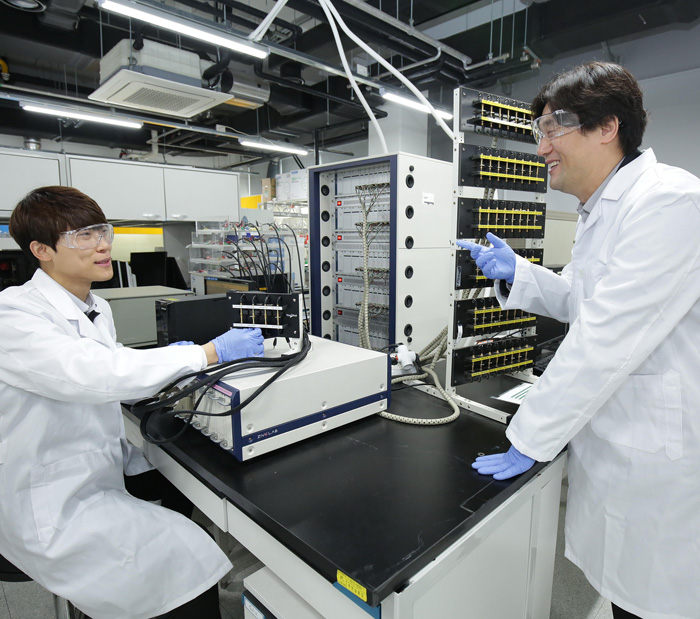
Energy Science YOON, WON SUB Prof.
Prof. Won Sub YOON develops high-performance battery that can travel up to 400km with one charge
A research team led by Prof. Won-Sub YOON, Department of Energy Science (DOES) at Sungkyunkwan University, has lifted the fundamental restriction on the breaking point of the lattice and unraveled the enigma of nickel effect on layered cathode materials that has existed for decades in the battery field. Consequently, they discovered the possibility of developing a high-performance battery which can travel up to 400km by one charge. While the technology of lithium ion batteries has been greatly successful since its advent in powering portable electronic devices, further advancements are insatiably demanding for wider applications such as in electric vehicles and grid-power storages. One of the key areas in these efforts is development of new positive electrode ‘cathode’ materials with higher energy densities to replace the lithium cobalt oxide that is currently prevailing as the cathode material. The research is very focused on increasing the amount of Li-ions ‘inserted’ in the electrode material, which affects the charge storage capacity, the speed of Li-ion movement within the crystal lattice of the electrode material, which affects the battery power, and the structural stability of the material upon in-and-out transport of Li-ion, which affects the battery life. Compared to other material families, the ‘layered’ materials are the most attractive in the sense of the three attributes listed above, and layered lithium transition metal oxides containing nickel (Ni), cobalt (Co) and manganese (Mn) have recently emerged as a promising family of cathode materials. Aside from lithium ions, other elements play a role as building blocks forming a host structure for Li-ions (guests) to be inserted or extracted. Depending on the properties of the host structure, its electrochemical performance as a battery material is determined. For these multi-component layered systems, the current trend moves toward increasing the content of Ni in layered systems (known as Ni-rich layered materials) since Ni is capable of uptaking and delivering twice the charge, i.e., Li-ions of the other two. As Ni atoms occupy a large part of the transition metal layer in the host structure, it becomes a major factor in determining the overall properties of the host structure. Therefore, understanding the effect of increasing Ni content on the layered structure is important to designing high-energy electrode materials. This series of materials containing Ni and other elements appear to inevitably have so-called ‘cation disorder,’ a phenomenon in which some of the Li-ions and Ni atoms switch positions from their own layers. This happens due to the fact that some of the Ni atoms exist in the valence state 2+ lower than Co or Mn as synthesized. The presence of Ni atoms in the Li-ion layer adversely affects the Li-ion movement in the Li-ion layer. In contrast to such a general perception, the study finds that the degree of cation disorders is mitigated upon increasing the Ni content in the lattice up to a certain concentration, and also reports that the oxidation state of Ni in the pristine compounds contributes significantly to cation disorder. Moreover, it is demonstrated that the extent of cation disorder critically affects the phase transition behavior during charging or discharging, and as a result, the phase transition becomes smoother with increasing Ni content. This smooth phase transition reduces the strain on structural behavior during cycling; consequently, it enhances the cycle performance of the electrode material. In addition to the relationship between the Ni content and the phase transition, it was discovered that the actual environment in which Li-ions are situated is not directly linked to the total height, a sum of the Li-ion layer and the transition metal layer (c-axis). The height of the lithium layer becomes larger with increasing Ni content, even though the c-axis decreases. More importantly, it is shown that the lithium ion channel retains the environment where lithium ions can visit or leave, even if the c-axis shrinks from the initial dimension. The results for the Ni-rich layered materials that are counter-intuitive account for the superior electrochemical performance, and address the misconception of Ni element in Ni-rich layered systems. Furthermore, this article provides a new perspective on the role of Ni in layered systems and disputes the conventional view concerning the c-axis parameter that has been considered a key factor in interpreting the behavior of Li-ion movement and the corresponding electrochemical performance. Hence, these results may suggest some aspects to consider in the design of high-energy electrode materials for next-generation batteries.
- No. 77
- 2018-07-05
- 3210
-
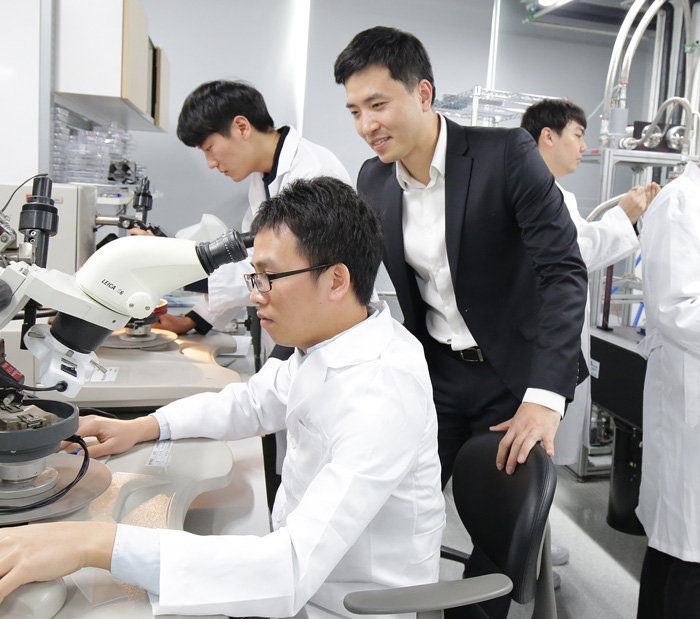
Electronic and Electrical Engineering YU, WOOJONG Prof.
Creation of Two-Terminal Tunneling Random Access Memory (TRAM) Inspired by Brain Neurons
A new memory device inspired by the neuron connections of the human brain has been designed. The research, published in Advanced Materials as a back cover paper, highlights the device's highly reliable performance, long retention time, and endurance. Moreover, its flexibility makes it a promising tool for the next-generation soft electronics attached to clothes or the body. The brain is able to learn and memorize thanks to a huge number of connections between neurons. The information humans memorize is transmitted through synapses from one neuron to the next as an electro-chemical signal. Inspired by these connections, scientists constructed a memory called two-terminal tunneling random access memory (TRAM), where two electrodes referred to as 'drain' and 'source' resemble the two communicating neurons of the synapse. TRAM is made up of a stack of one-atom-thick or a few-atoms-thick 2D crystal layers: the semiconductor molybdenum disulfide (drain and source), a tunneling insulator of aluminum oxide (Al2O3), and a floating gate of graphene layer. The researchers secured a large-area memory integration technology using a large-area grown graphene and a two-dimensional semiconductor through chemical vapor deposition (CVD). In simple terms, memory creates program (logical-0) and erase (logical-1) states by charging and discharging the graphene floating gate through the h-BN tunneling barrier. By effective charge tunneling through the crystalline h-BN layer and storing charges in the graphene layer, TRAM demonstrates an ultimately low off-state current of 10-14 A, leading to ultra high off/on ratio over 109 about 103 times higher than other two-terminal memories. Furthermore, the absence of thick, rigid blocking oxides enables high flexibility, which is useful for soft electronics. Our memory device can be useful for next-generation neuromorphic systems and wearable, body-attachable electronics in the near future.
- No. 76
- 2018-07-05
- 2058
-
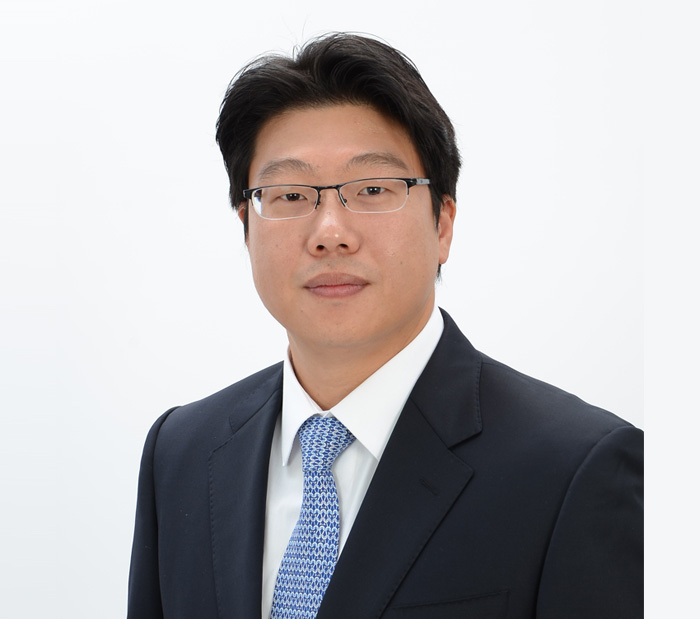
Business Administration KIM, SANGKYUN Prof.
Research on Short Career Horizons and Firm Innovation by Prof. Sang Kyun KIM
As the business environment is rapidly changing, firms are required to formulate and implement strategies which help them to adapt to environmental and technological changes, to achieve innovation and long-term competitive advantages, and even to survive. Strategy scholars view a company's chief executive officer (CEO) as the most powerful actor in the decision-making process and call for further research to understand the role of CEOs in the innovation process beyond the simple relationship between CEOs' personal characteristics and financial performance. Building on labor market evaluations and legacy conservation motivation perspectives that explain risk aversion by CEOs facing a short career horizon, this study seeks to unpack the mechanisms linking a CEO's career horizon to a firm's breakthrough innovations. Using 10-year panel data from 681 U.S. firms, we find that a short career horizon induces a CEO to become risk-averse and thus forego investing in risky breakthrough innovations because they could harm the firm's short-term performance, endangering job prospects and CEO legacies in the short term. The results also show that the impact of a short career horizon on breakthrough innovations is partially mediated by a reduction in R&D spending. Furthermore, different performance implications associated with a firm’s exploitation and exploration activities affect a CEO's willingness to commit to such breakthrough innovations. That is, when a firm leverages internal knowledge within a familiar technological domain (i.e., a focus on exploitation), this mitigates the behavioral tendencies of a CEO with a short career horizon, such as not pursuing breakthrough innovations, while such behavioral tendencies are exacerbated when a firm applies external technologies with an unfamiliar trajectory (i.e., a focus on exploration). This study contributes to the literature on CEO decision-making and firm innovation. First, our study contributes to the literature on CEO decision-making by elucidating a mechanism that can explain the influence of a CEO’s career horizon on a firm’s ability to generate breakthrough innovations. Second, we emphasize the role of CEOs in the innovation process by suggesting that motivational factors can shape a CEO’s willingness to allocate firm resources to risky projects, which in turn can affect firms achieving breakthrough innovations. Practically, this research provides insights to those seeking to develop breakthrough innovations and manage organizational learning and innovation process for their firms. The alignment between a CEO’s willingness to take risks and a firm’s emphasis on organizational learning in both familiar and unfamiliar technological trajectories has an influence on firm innovations. It implies that CEOs play an important role in producing breakthrough innovations and that a strategic alignment between the willingness to take risks and the firm’s engagement in risky strategies can enable the firm to achieve greater innovations.
- No. 75
- 2018-07-05
- 1877
-
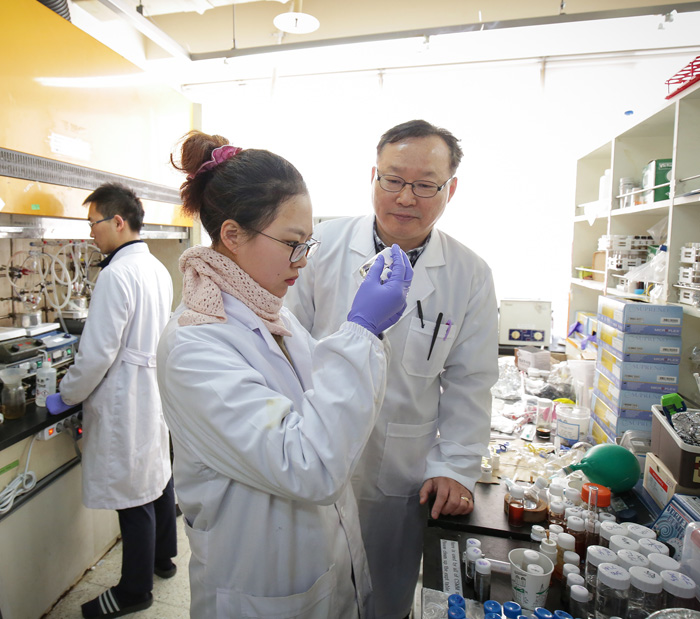
Chemistry LEE, HYOYOUNG Prof.
Highly Efficient Thin-Film Transistor via Cross-Linking 1T Edge Functional 2H Molybdenum Disulfides
Research on flexible thin film transistors (TFTs) has been steadily under way, with the next generation devices being noted. Molybdenum disulfide (MoS2), one of the two-dimensional materials, has excellent optical, electrical and chemical properties and is used in field effect transistors (FETs). However, most of the synthesis studies are concentrated on chemical vapor deposition, and it is necessary to make a method to manufacture MoS2 while maintaining crystallinity through an inexpensive solution process. In this study, MoS2 FET was implemented through a solution process by selectively modifying the edge of MoS2 only with organic compounds, without using metal ions at all. The paper was published in ACS Nano (2017, 11, 12832-12839) by the researchers led by Hyoyoung LEE (CINAP-IBS, Professor of Chemistry) with Mun Seok JEONG (Professor of Energy Science). To exfoliate the 2D MoS2 bulk materials into single-layer edge-1T basal-2H MoS2 sheets, they used 4-carboxy-benzenediazonium (+N2-benzene-COOH) tetrafluoroborate. Edge-exposed nucleophilic sulfides of the bulk MoS2 can act as substitutes for the electrophiles of +benzene-COOH diazonium salts. The chemically attached polar COOH functional group facilitates the exfoliation by creating an increased electrostatic repulsion force between the MoS2 nanosheets. As a result, the configuration of the resulting exfoliated HOOC-benzene-MoS2 sheets (e-MoS2) is changed to the conducting 1T or 1T′ phase through functionalization at the edge part, while remaining in the semiconducting 2H phase at the basal plane. Compared with n-BuLi exfoliated MoS2 (n-MoS2) and basal plane functionalized MoS2 (b-MoS2), which mainly have metallic 1T or 1T′ phase during the chemical treatment showing the on/off ratio of <100, e-MoS2 has a relatively high mobility (μ= 1.2 cm2/(V s) and on/off ratio (= 106) due to the low number of defect sites in the e-MoS2 nanosheets. PDDA (polydiallyldimethylammonium chloride) is used as a cationic layer, while e-MoS2 is used as an anionic layer for the channel film formation. Cross-linking via hydrogen bonding of the negatively charged COOH of the e-MoS2 sheets with the help of a cationic polymer provided good film formation for solution processing TFT channels. The e-MoS2 TFT exhibited great electrical performance (average mobility of 170.8 cm2/(V s) at 1 V and on/off ratio of 106) on SiO2/Si substrates and also a high mobility of 36.34 cm2/(V s) (on/off ratio of 103) on PDMS/PET substrates for flexible TFTs.
- No. 74
- 2018-07-05
- 2093
-
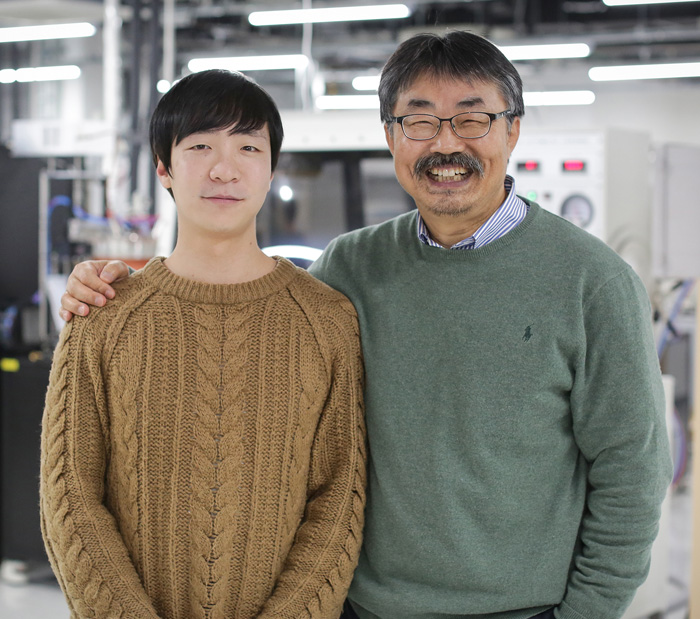
Physics LEE, YOUNGHEE Prof.
Development of a New Method for Converting MoS2 into MoTe2 by Prof. Young Hee LEE
Prof. Young Hee LEE, Center for Integrated Nanostructure Physics, Institute for Basic Science at Sungkyunkwan University has successfully developed a new method for converting monolayer molybdenum disulfide (MoS2) into molybdenum ditelluride (MoTe2) via substitution of tellurium to MoS2 by chemical vapor deposition (CVD). In order to trigger such a substitutional reaction, High reaction temperature is necessary for Te-substitution but the instability arises because of lower thermal stability of MoTe2 than that of MoS2. Although the MoTe2, which is product after Te-substitution, is vaporized above 700 °C due to the thermal instability, the substitutional reaction below 700 °C is no longer possible. To resolve this issue, we introduced sodium telluride (Na2Te) as a telluriding catalyst and further was able to achieve stable MoTe2 by provoking substitutional reaction at temperature below 700 °C. The research team confirmed that the Te-substitution reaction occurs preferentially from the edge and grain boundary of the MoS2 flake and further constructed lateral hetero semiconductor junction of MoS2-MoTe2. Furthermore, various phases such as alloy (MoS2-xTex), semiconductor (2H-MoTe2), and metal (1T’-MoTe2) were obtained by adjusting experimental parameters of temperature and sodium concentration. We also demonstrated that the band gap of MoS2-xTex alloy can be modulated by controlling the tellurium composition. Dr. Seok Jun YUN, the leading scientist of the research team, predicted that "It is possible to synthesize compound materials by a substitutional technique even for the unstable compounds." The conversion method using the telluriding catalyst (Na2Te) can be applied not only to MoS2 but also to tungsten disulfide (WS2), which is another type of transition metal dichalcogenide. This research, conducted by prof. Young Hee Lee and Seok Joon Yun who is the first author of this research, was published in Nature Communications (IF 12.124), a worldwide scientific journal in science and technology, on December 18.
- No. 73
- 2018-07-05
- 2614
-
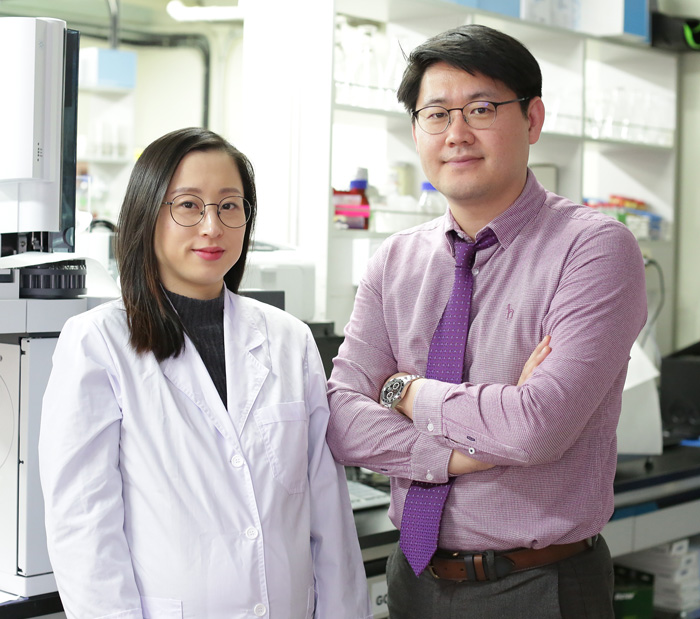
Food Science and Biotechnology WOO, HAN MIN Prof.
Photosynthetic Production of α-farnesene from CO2 by Profs. Han Min WOO & Hyun Jeong LEE
Solar-to-chemical and solar-to-fuel production from CO2 have been developed using engineered microorganisms that assimilate CO2 and convert target chemicals and fuels using solar energy. In addition to integrated bio-electrochemical systems, photosynthetic cyanobacteria have been metabolically engineered to redirect CO2 to value-added chemicals as bio-solar cell factories. The research team of Profs. Han Min WOO and Hyun Jeong LEE reported the metabolic engineering of unicellular Synechococcus elongatus PCC 7942 to improve the photosynthetic production of α-farnesene from CO2 in the Journal of Agricultural and Food Chemistry, December 6, 2017. As a result of the lack of farnesene synthase (FS) activity in the wild-type cyanobacterium, the research team metabolically engineered S. elongatus PCC 7942 to express heterologous FS from apple fruit, resulting in detectable peaks of α-farnesene. To enhance α-farnesene production, an optimized methylerythritol phosphate (MEP) pathway was introduced in the farnesene-producing strain to supply farnesyl diphosphate. Subsequent cyanobacterial culture with a dodecane overlay resulted in photosynthetic production of α-farnesene from CO2. Prof. WOO said that to the best of our knowledge, this is the first report of photosynthetic production of α-farnesene from CO2 in the unicellular cyanobacterium S. elongatus PCC 7942. This engineered strain could be further optimized to accelerate the development of bio-solar cell factories to convert CO2 to α-farnesene as a value-added bioproduct (fragrance, surfactants, etc.) or α-farnesane, a potential bio-jet fuel. This work was supported by the Korea Carbon Capture & Sequestration R&D Center (KCRC, 2017M1A8A1072034) and the Basic Science Research Program (2017R1A2B2002566 and 2017R1A6A3A01011460) through the National Research Foundation of Korea, funded by the Korean Government [Ministry of Science and Information and Communications Technology (ICT)]. The full article can be accessed at http://pubs.acs.org/doi/full/10.1021/acs.jafc.7b03625.
- No. 72
- 2018-07-05
- 2215
-
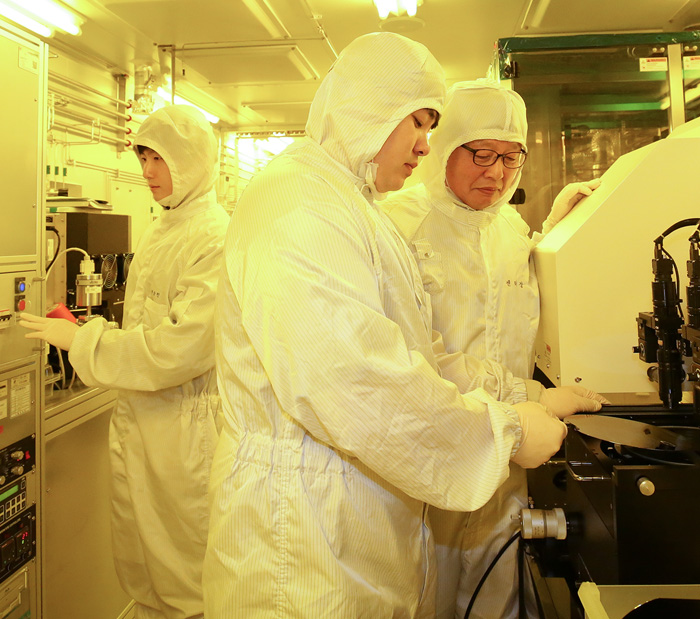
Advanced Materials Science and Engineering SUH, SUJEONG Prof.
Production of Multilayer Graphene Composite Metals and Alloy Hybrid Nanoparticles
Prof. Su Jeong SUH, Director of the Advanced Materials and Process Research Center for IT, deployed infrastructure for research equipment, including a semiconductor process clean room and ultra-precision material analysis equipment, by receiving the designation of Technology Innovation Center (TIC) from the Ministry of Commerce Industry and Energy in 1999. He conducted R&D projects using equipment built with TIC projects after receiving the designation of Regional Research Center (RRC) from the Ministry of Science and Technology in 2002. In addition, he was designated Regional Innovation Center (RIC) by the Ministry of Commerce Industry and Energy in 2006 to expand the industry-university cooperation research infrastructure and also continued to operate diverse education projects and business support projects, including workforce training for semiconducting processes, education in science and engineering for the unemployed, technical exchange meetings, and process technology support. Recently, he was selected as the Smart e-Plating Regional Innovation System (RIS) in 2012, Gyeonggi Regional Research Center (GRRC) by the Ministry of Commerce Industry and Energy, and as the base university of an ernergy cluster project by the Korea Electronic Power Corporation (KEPCO) in 2017. The group is expanding its research into the field of surface treatment processing and advanced sensors and works as a bridghead for intramural academic-industrial sectors. Research Field The Magnetic Material Laboratory of the Department of Advanced Materials Science and Engineering has performed 10 technology transfers and 22 registrations of internal and external patents (7 external) in the past three years. Moreover, recently, Research Professor Young Il SONG has done research as a key person in the laboratory, easily producing eco-friendly multi graphene layer coated single or alloy metal nanoparticles (MGMNs) using a wire electric explosion method. These MGMNs have received widespread attention because of the unique structure of the multi-graphene shells encapsulating second-phase metal cores. The metal particles serve as a protection against environmental degradation effects and oxidation. Furthermore, these novel MGMNs induce unique electronic, optical, and magnetic properties due to quantum confienement and very high surface per volume ratio, which are undoubtedly important for the evolution of nanotechnology. In addition, these MGMNs can be used in various application materials such as energy storage materials, electrode paste, printable ink, catalysts, ferrofluids, and sensors. Our researchers have unfolded not only the development of MGMNs by electric explosion method, but also the development of MGMNs with various metal core nanoparticles by chemical coprecipitation method. This technology also contributes to the increase of battery capacity and the enchancement of power moment output using graphene filme and thse metal nanoparticles on current collectors of lithium ion batteries. We are conducting further research on MGMN-based application devices.
- No. 71
- 2018-07-05
- 2258
-
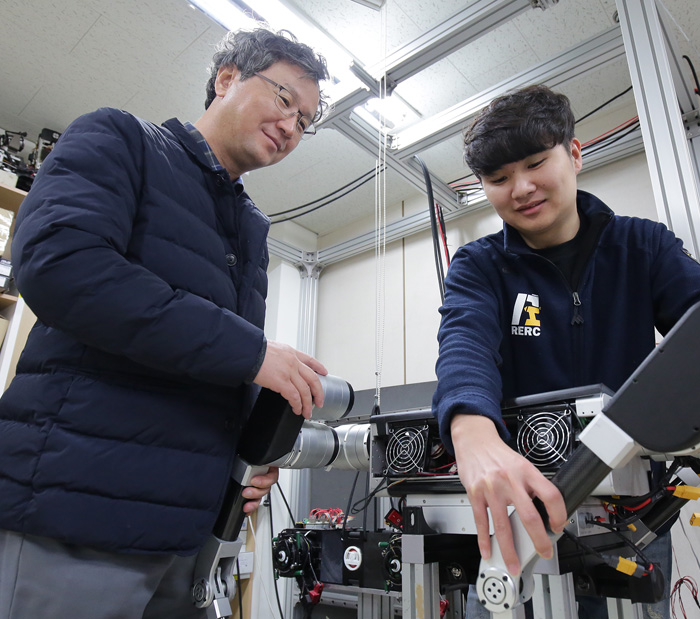
Mechanical Engineering CHOI, HYOUK RYEOL Prof.
Prof. Hyouk Ryeol CHOI Leads the World's Best Professional Service Robot Technology
Prof. Hyouk Ryeol CHOI (Sungkyunkwan University, School of Mechanical Engineering) established the Intelligent Robotics and Mechatronics System Laboratory (IRMS; it has been changed to Robotics Innovatory, abbreviated RI) in 1995 and has performed research mainly focused on professional service robotics during the last 20 years. For example, smart inpipe inspection robots, ultra long span bridge inspection robots, maintenance robots for sewer and water supply systems, quadruped walking robots for field operations, multi-fingered robot hands and manipulation technology, soft actuators and sensors, and interaction sensing technology for robotics are the subjects of research done by Prof. CHOI with governmental and industrial funding. In addition, Prof. CHOI actively collaborates with researchers from foreign countries such as UNLA, UCLA, UNLV, Qatar University, etc. One of the field robots developed by Prof. CHOI can be MRINSPECT VII. This robot contains most of the core technologies developed by Prof. CHOI on inpipe robot technologies, which can intelligently move inside of urban gas pipelines in service without external support. Its operation has been tested recently in real gas pipelines and proved to be effective in practical applications. MRC^2 IN Series is another field robot dedicated to bridge maintenance service. Among them MRC^2 IN has been built recently for service in cable-supported suspension bridges, which can move over 100mm during the operation. The robot has been tested in Yongjong Grand Bridge in Incheon and validated. Interaction sensing technologies are for sensing physical interactions between robots and the environment such as humans, and thus, force, torque, and proximity caused by the interaction are sensed. Prof. CHOI leads the world's best interaction sensing technologies, especially capacitive type technologies. He has many patents and transferred to the company for commercialization,notably the 6-axis force/torque sensor RFT series. The sensor becomes a strong competitor in the market dominanted by US and Japanese companies. Prof. CHOI has outstanding academic achievements with more than 170 journal papers, books, and 380 proceedings, as well as over 130 domestic and international patents. With these contributions, he received the Grand Robot Prize from the Ministry of Trade and Commerce in 2014, the Academic Career Award from the Korea Robotics Society, the Korea Patent Award, The 10th Achievement Award of Mechanical Engineering in 2016, and the IEEE ICRA Best Human Robot Interaction Paper Award.. He will be the president of the Korea Robotics Society in 2018 (homepage: http://mecha.skku.ac.kr).
- No. 70
- 2018-07-05
- 3095
-
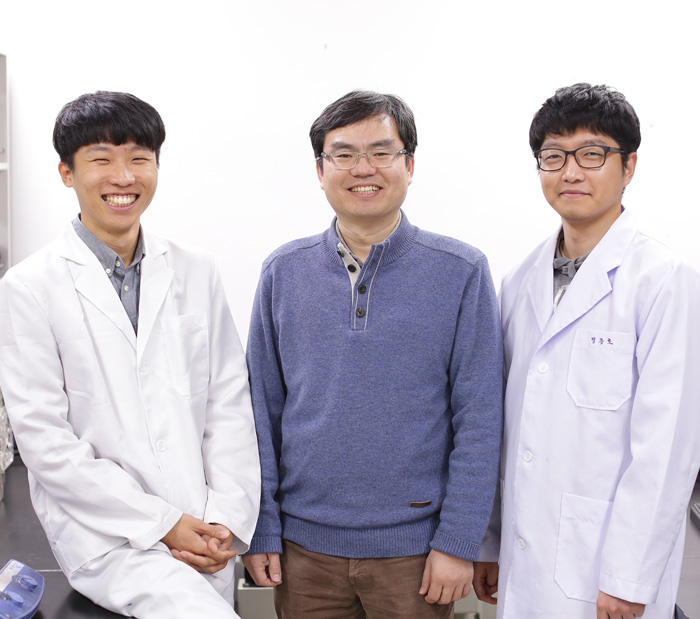
Mechanical Engineering LEE, CHANG GU Prof.
Identification of Crystal Lattice Structure of 2-dimensional Magnetic Semiconductor
A team of Prof. Chang Gu LEE’s group (School of Mechanical Engineering, SKKU) and Prof. Sunmin RYU’s group (Department of Chemistry, Postech) identified the crystal lattice structure of a new 2-dimensional (2D) magnetic semiconductor using optical characterization methods. 2D materials, such as graphene, have atomic thickness and exhibit excellent electrical, mechanical and chemical properties, thus are expected to find abundant applications in next-generation opto/electronic devices. The recently studied binary metal chalcogenides, such as MoS2, consist of 2 elements and show various electrical characteristics and will be used for flexible electronics and displays. However, These materials lack one important physical property, which is magnetism. Since silicon-based electronic circuits are approaching the physical limit in their performances, scientists are searching for alternative electronic devices and materials. Hence, they are paying attention to spintronic devices, which utilize spin along with charge of electrons for device operation. Now, 2D magnetic semiconductors can be a good candidate material for spintronic devices and circuits due to low-dimensionality. The team studied a ternary 2D magnetic semiconductor CrPS4, which consist of chromium, phosphorus, and sulfur to investigate its lattice structure using an optical microscope and Raman spectroscopy and confirmed it with a tunneling electron microscope. It is an antiferromagnetic material and has anisotropic in-plane structure. Therefore, its optical and electrical properties can be dependent on its crystalline orientation. When the polarized light was irradiated on the crystal, the light showed different reflection intensity depending on the crystal direction. And the lattice structure could be identified from angle measurement. This was an important result because the crystal orientation of a material is usually determined by an expensive tool such as tunneling electron microscope. This method can provide a simple but powerful tool for 2D materials researchers to check the crystalline orientation easily and lower the barrier to high-quality experiments. This research will enable many researchers to study these kind materials with ease and can contribute to the studies of spintronics using 2D magnetic semiconductors. This work was published in ACS nano on Nov. 28, 2017. 본 연구는 ‘ACS nano’ 온라인판 10월 25일자에 게재되었으며 광학기술정보통신부와 정보통신기술진흥센터에서 지원하는 사업이다. ETRI와 공동으로 수행하는 ‘차세대 신기능 스마트디바이스 플랫폼을 위한 대면적 이차원소재 및 소자 원천기술 개발’의 일환으로 개발되었다.
- No. 69
- 2018-07-05
- 2096
-
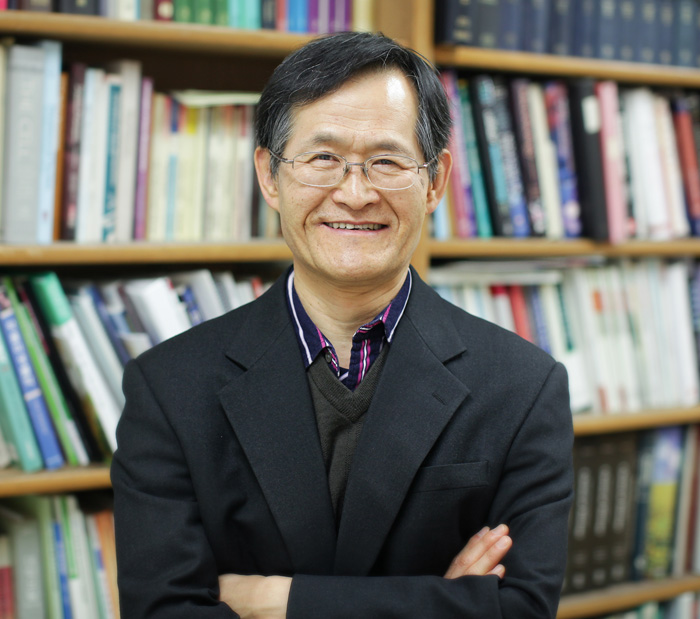
Pharmacy RHEE, DONG KWON Prof.
Development of a pneumococcal vaccine preventing influenza virus as well as pneumococcal infections
A team of Prof. Dong-Kwon RHEE (School of Pharmacy, SKKU) and Dr. Man-Ki SONG (International Vaccine Institute; IVI) developed a novel vaccine which can prevent influenza (flu) virus and pneumococcal infections. In this study, PhD student Seung Han SEON and Prof. Sukneung PYO (SKKU), Dr. Jung Ah CHOI and Eunji YANG (IVI) have been participated. The vaccine they developed is highly feasible as a novel vaccine for preventing or mitigating influenza virus as well as pneumococcal infections. To prevent flu infection, it is highly recommended to have flu vaccine every year. Also for pneumococcal diseases prevention, 23 valent polysaccharide vaccine or 13 valent conjugate vaccine is recommended. However, live attenuated vaccine they developed can prevent these irrelevant two infections at the same time. In the year 2009, a new variety of flu virus infection could lead to significant mortality, due to secondary bacterial infection such as pneumococci and Staphylococcus aureus after flu virus infection. Thus, it is essential to develop a vaccine which can prevent secondary bacterial infections after flu pandemic. However, current 13 valent conjugate vaccine could not prevent the pneumococcus infection effectively after flu infection (Metzger et al., 2015). They developed an attenuated pneumococcus vaccine devoid of ‘pep27’ gene and immunized mice intranasally. Subsequently, the immunized mice were challenged with flu virus followed by pneumococcus infections. Immunized group showed significantly higher survival rate than the non-immunized group. Through this study, they also discovered that mice immunized with the live attenuated pneumococcal vaccine showed no body weight decrease after flu virus infection. Since body weight decrease is a token of flu virus infection, this discovery is highly meaningful. Moreover, flu virus titer in the immunized mice lung was much lower than the non-immunized control. This finding can provide a mile stone on vaccine development since vaccine is considered to prevent only a specific pathogen. They are now studying how this intranasal vaccine can provide protection from flu virus as well as pneumococcal infections. Also they are checking whether this vaccine can provide other pathogens infections. This study is supported by Korea Science Foundation and published in advance as a brief report in Journal of Infectious Diseases (Impact Factor 6.273: infectious diseases category top 92.26%) on June 14. Published article: · Seon SH1#, Choi JA2#, Yang E2, Pyo S1, Song MK2*, Rhee DK1*, Intranasal Immunization with an Attenuated Pep27 Mutant Provides Protection from Influenza Virus and Secondary Pneumococcal Infections. J Infect Dis 2017; In Press Abstract: https://academic.oup.com/jid/article-abstract/doi/10.1093/infdis/jix594/4627914 Article (free access): https://academic.oup.com/jid/article/doi/10.1093/infdis/jix594/4627914?guestAccessKey=8a78f6ee-1a14-480a-92e9-5828b113a888 Reference: · Metzger DW, Furuya Y, Salmon SL, Roberts S, Sun K. Limited Efficacy of Antibacterial Vaccination Against Secondary Serotype 3 Pneumococcal Pneumonia Following Influenza Infection. J Infect Dis 2015; 212:445-52.
- No. 68
- 2018-07-05
- 2496
-
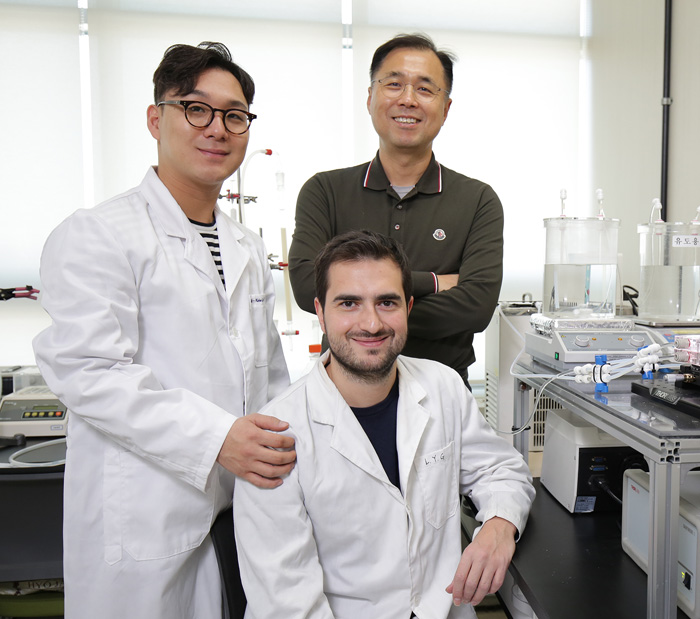
Graduate School of Water Resources JANG, AM Prof.
Development of Energy-saving Volume Retarded Osmosis(VRO) - Low Pressure Membrane(LPM) Hybrid System
Development of energy-saving volume retarded osmosis (VRO)-low pressure membrane (LPM) hybrid system for water treatment and identification of initial fouling mechanism in forward osmosis water treatment process. Dr. Am JANG, a Professor from the College of Construction and Environmental System Engineering and Graduate School of Water Resources, and his research team have developed volume retarded osmosis (VRO)-low pressure membrane (LPM) hybrid system. The discovery of such novel process has lead to a publication of a paper in "Scientific Report (Impact factor=4.259, upper 16% of JCR journal in multidisciplinary sciences field)", a journal from the publishers of Nature, on November 6th, 2017 (online). Additionally, they have identified the initial organic fouling phenomenon that could occur in spiral-wound forward osmosis process at semi-pilot scale, with the use of real wastewater and the membrane surface analysis method. This lead to a publication in "Chemical engineering journal (primary author: Sung-Ju Im, phD student) (Impact factor = 6.216, upper 4.5% of JCR journals in chemical engineering field)", one of the most powerful and effective journals around the world, on November 2, 2017. Forward Osmosis (FO) technology is a water treatment technology based on the osmotic pressure gradient of both solutions (feed and draw). It has been actively studied in academia and industry, and is considered as a substitute for reverse osmosis-based seawater desalination technology and a next-generation desalination technology. In general, since the forward osmosis technology requires a post-treatment technique for separating the draw solute from a high concentration of the draw solution, many researches and attempts have been made to develop an appropriate post-treatment technique. However, the high operating pressure (energy) of the post-treatment technology is pointed out as a limitation of the forward osmosis technology, and the development of a forward osmosis process that does not require post treatment, or post treatment with low or no energy requirement is urgently needed. Through this research, Professor JANG and his research team, was the first to devise and develope a water treatment system design that can utilize the pressure to be used as the driving force for the low pressure membrane, via increase of draw solution volume in a closed tank. The value of this study is unmeasureably high, seeing as how the limitation of the existing osmosis process was improved, the possibility of practical use of the osmosis process was increased, and the direction of the new osmosis technology was suggested through this study. In addition, the spiral-would forward osmosis element is the most common form of the conventional element types, and it is similar to the reverse osmosis module that is used for seawater desalination. To date, the identification of the fouling phenomena of forward osmosis membranes has been limited to laboratory scale (Lab-scale) or to identifying them using model foulants. However, there are limitations in terms of operating conditions and structural characteristics of elements in order to apply the results to the actual process (element scale or pilot scale). Professor JANG’s research team determined the initial fouling mechanism, when spiral-wound forward osmosis element was used with wastewater as feed solution. The results of this study is very valuable, for it can help comprehensively understand the fouling mechanism of the forward osmosis, allow prediction of overall fouling phenomena in actual process, and help understand overall development of forward osmosis process. Professor Am JANG, who conducted and led the study, said, "The results of this study have a great significance in overcoming the limitation of the forward osmosis process, a next generation water treatment technology. Not only it is significant, but the results from this study is also valuable, since understanding of the fouling phenomena is the key factor in development of forward osmosis technology. " Based on the results of this study, Im Sung-Ju, a phD student and the first author of the published paper, presented at the International Desalination Workshop 2017, and was awarded by the Minister of Land, Transport and Tourism. This study was carried out through researches on forward osmosis-reverse osmosis hybrid system, which is supported by Korea Agency for Infrastructure Technology Advancement, and through monitoring of irreversible foulants in the osmosis - based membrane process, supported by the research project of the Korea Research Foundation. Titles of the published papers: - New concept of pump-less forward osmosis (FO) and low-pressure membrane (LPM) process - Organic fouling characterization of a CTA-based spiral-wound forward osmosis (SWFO) membrane used in wastewater reuse and seawater desalination
- No. 67
- 2018-07-05
- 1867


